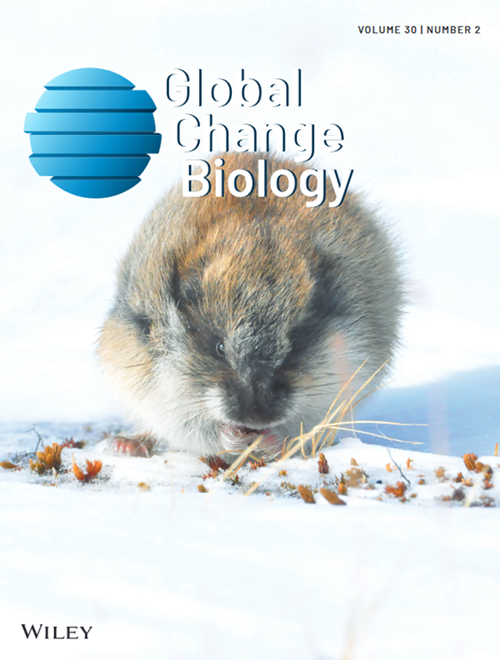Biological Processes Underpin the Persistence of Dryland Productivity Following Extreme Wet Years
IF 12
1区 环境科学与生态学
Q1 BIODIVERSITY CONSERVATION
引用次数: 0
Abstract
Global warming has induced more years of above‐average rainfall, significantly affecting the interannual variability of the terrestrial global carbon cycle. An extreme wet year can cause changes to vegetation structure and function that persist beyond itself, referred to as “legacy effects”. The physical and biological mechanisms underlying these effects are poorly understood, introducing uncertainty into climate–carbon models to accurately represent post–wet year vegetation dynamics. Here we used multi‐source satellite‐derived vegetation productivity metrics, as well as eddy covariance (EC) measurements, to investigate the legacy effects of extreme wet years on the productivity of Australia's drylands. We found that the impact of the 2010–2011 extreme wet year extended beyond generating a record‐breaking carbon uptake, which exceeded the 40‐year mean by more than 1.5 standard deviations. It also resulted in a widespread positive legacy effect in the following year. Specifically, up to 56% of the vegetated areas that experienced anomalous wetness showed significant legacy effects after 1 year, with impact size contributing up to 40% of total productivity in those regions. Biological memory in wet years, representing a potential process for carbon storage and subsequent remobilization, was shown to dominate the legacy effect. Random forest analysis identified key ecogeographic controls on biological memory, such as resource‐conservative strategies associated with drier climates and relatively fertile soils. Comparisons with Dynamic Global Vegetation Models (DGVMs) further revealed that current models may underestimate this biological memory by up to 70%, in part due to limited representation of carbon storage dynamics. Our results contribute to more accurate modelling of the dryland carbon cycle and provide a framework to better account for post‐wet‐year legacy effects by incorporating the influence of wet‐year productivity.生物过程支持极端潮湿年份后旱地生产力的持续
全球变暖导致降雨量超过平均水平的年份增加,显著影响了陆地全球碳循环的年际变化。极端潮湿的年份会导致植被结构和功能的变化,这种变化会持续下去,被称为“遗留效应”。这些影响背后的物理和生物机制尚不清楚,这给气候-碳模型带来了不确定性,无法准确地代表湿后年的植被动态。在这里,我们使用多源卫星衍生的植被生产力指标,以及涡动相关(EC)测量,来研究极端潮湿年对澳大利亚旱地生产力的遗留影响。我们发现,2010-2011年极端潮湿年的影响超出了创纪录的碳吸收量,超过了40年平均值1.5个标准差以上。它还在接下来的一年产生了广泛的积极遗留效应。具体而言,在经历过异常湿度的植被区域中,高达56%的植被区域在1年后表现出显著的遗留效应,影响规模对这些地区总生产力的贡献高达40%。湿年的生物记忆,代表了碳储存和随后的再动员的潜在过程,被证明主导了遗产效应。随机森林分析确定了生物记忆的关键生态地理控制,例如与干燥气候和相对肥沃的土壤相关的资源保守策略。与动态全球植被模型(dgvm)的比较进一步表明,目前的模型可能低估了这种生物记忆高达70%,部分原因是碳储存动态的代表性有限。我们的研究结果有助于更准确地模拟旱地碳循环,并通过纳入湿年生产力的影响,为更好地解释湿年后遗留效应提供了一个框架。
本文章由计算机程序翻译,如有差异,请以英文原文为准。
求助全文
约1分钟内获得全文
求助全文
来源期刊

Global Change Biology
环境科学-环境科学
CiteScore
21.50
自引率
5.20%
发文量
497
审稿时长
3.3 months
期刊介绍:
Global Change Biology is an environmental change journal committed to shaping the future and addressing the world's most pressing challenges, including sustainability, climate change, environmental protection, food and water safety, and global health.
Dedicated to fostering a profound understanding of the impacts of global change on biological systems and offering innovative solutions, the journal publishes a diverse range of content, including primary research articles, technical advances, research reviews, reports, opinions, perspectives, commentaries, and letters. Starting with the 2024 volume, Global Change Biology will transition to an online-only format, enhancing accessibility and contributing to the evolution of scholarly communication.
 求助内容:
求助内容: 应助结果提醒方式:
应助结果提醒方式:


